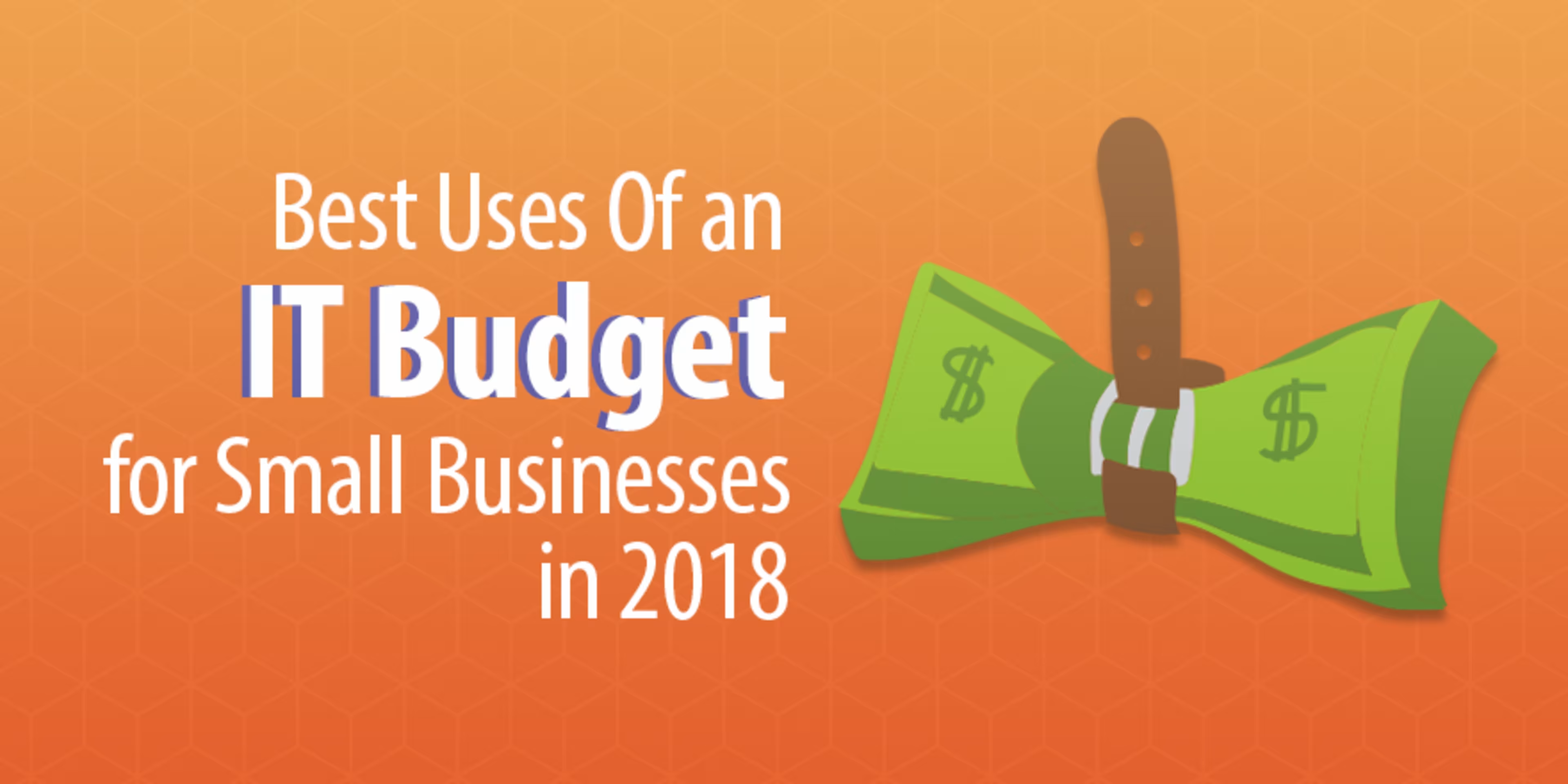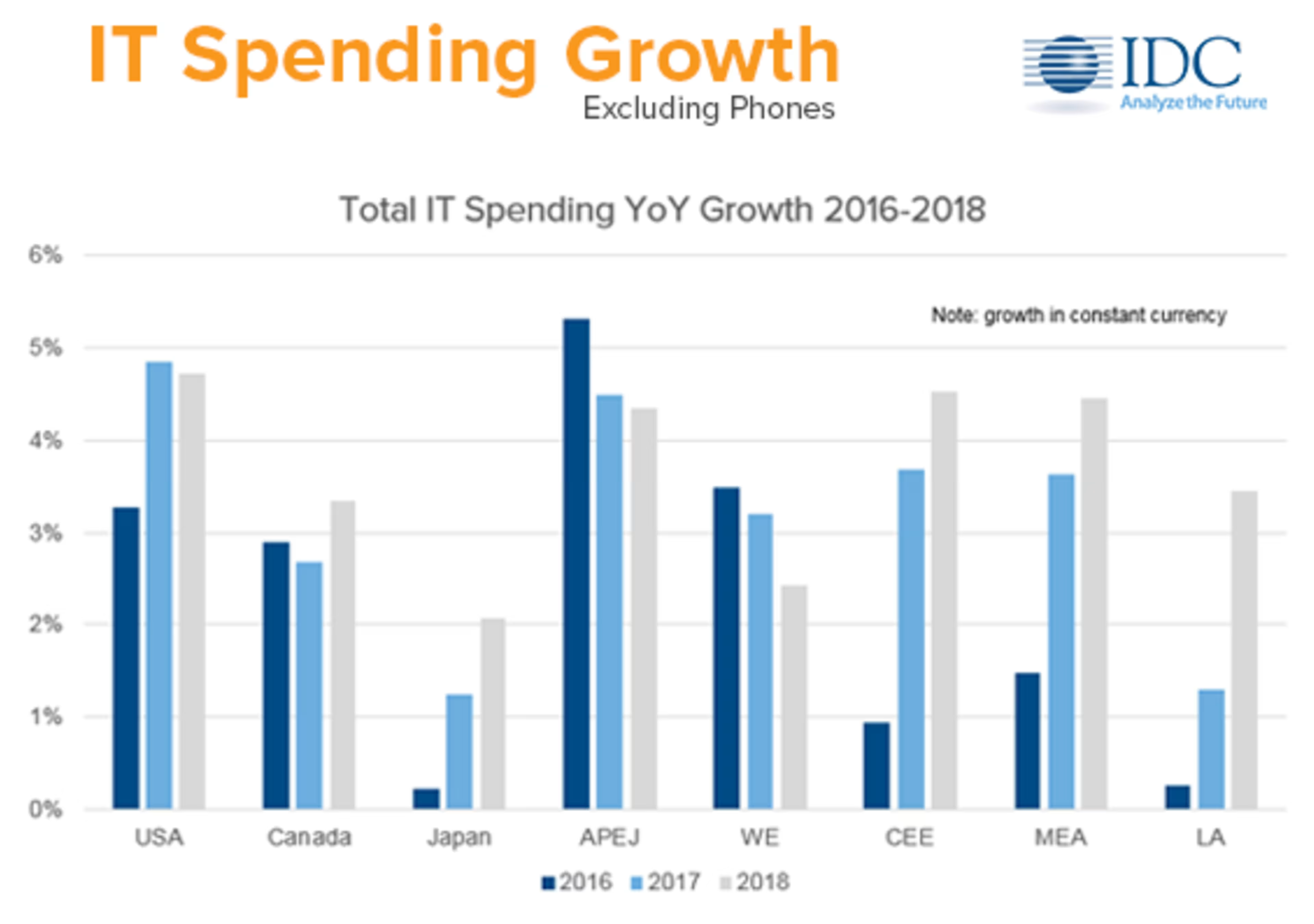Business tech is everywhere. You don't have to go far in your workplace to encounter web apps or network equipment that increases business agility, cuts costs, and lowers administrative burdens.
It's no surprise that more than half of all IT professionals in the U.S. plan to increase their organization's IT budget for 2018, with global IT spending predicted to reach around $3.7 trillion this year.
Spending more on IT doesn't automatically increase efficiency or ROIs, however, as the tech landscape is evolving rapidly. With the release of game-changing technologies every few months, CIOs need to monitor the pulse of tech advancements to ensure that their companies are putting money behind the right technology for their business.
To that end, we've identified five areas representing the best uses for your 2018 IT budget and paired each with some actionable tips for your small business.

1. Hiring and training
This probably isn't the first thing that enters your mind when you think about your IT budget, but it's first on this list because hiring and training qualified IT professionals is the most important use of your tech funds in the year ahead.
The IT sector has faced a substantial skill shortage in recent years. As technology becomes more specialized and less accessible to untrained workers, companies need to begin aggressively hiring for certain skill sets.
It's also getting harder to fight redundancy in tech, as existing skills need to be constantly revised and refined to keep up with new technological standards.
Moving forward, you need to hire IT professionals with experience in applied machine learning, data science, digital transformation, and other specialized subject areas.
Of course, you can't neglect existing employees, either. Expect a lot of companies to push for training and certifications in 2018. Whether you're trying to get employees to configure enterprise-level networks or identify cybersecurity risks, make sure your IT budget leaves room for continued employee growth.
Top tip: If you're a small business looking to recruit a specific skill set, your best course of action is hiring for talent and fit. After that, focus on upskilling your new hires.
2. The internet of things
If you've lived anywhere other than under a rock this past year, chances are you've heard of the internet of things(IoT). Most of the IT crowd is ready to invest in this emerging technology, with over 65% of tech decision-makers set to increase their IoT spending in 2018.
Some companies remain unsure about capitalizing on the IoT hype, especially because they can't envision it as something that works on a smaller scale. But: the internet of things doesn't have to be all that complex.
Ben Hayes, chief marketing officer of StartupBootCamp (an IoT startup accelerator), says:
In 2018, small and medium-sized enterprises (SMEs) will be able to access IoT technology more than ever before, thanks to the decreased cost of sensors and software platforms.
Therefore, while you can—and probably should—use the IoT for high-ticket operations like facility automation and fleet management, you can use it just as well for smaller projects such as temperature control, smart doors, and power sensors. These solutions are cheap, easily accessible, and can significantly reduce your business' administrative overheads.
Top tip: Starting small is a good first step to IoT adoption, especially for smaller companies. The sooner you adopt, the better!
3. The cloud
The cloud is expanding; the size of the public cloud computing market was $130 billion in 2017 alone.

(via IDC)
These days, most businesses rely on cloud applications for streamlined operations. The cloud makes access extremely convenient, and offers a cheaper solution for businesses looking to dodge infrastructure and implementation costs. Cloud apps are scalable, and let you track and manage real-time data.
This kind of flexibility and agility is a must in today's competitive arena.
All you need to hold certain departments accountable at your organization is a cloud app, an internet connection, and someone who loves logging and organizing data. Take your IT department as an example.
Your system administrators are managing scores of IT assets—including hardware and software—and trying to track and manage licenses, warranties, maintenance schedules, and custodianship records. Robust IT asset management lets you easily assess and report on your IT asset landscape, especially if you're compliant with IT best practices.
Cloud-based IT asset tracking software lets you do all this and more, helping you optimize workflows with the click of a few buttons. The convenience alone makes a solid case for your company to invest a portion of your IT budget in cloud apps this year.
Top tip: Make sure you select a cloud product with round-the-clock support, API access, and pay-as-you-grow plans so you're not putting undue pressure on your budget.
4. Cybersecurity
As dependence on IoT and cloud technologies increases, so will your cybersecurity budget. A Gartner study predicts that global expenditure on information security will grow to $93 billion in 2018, up from $86 billion last year.
So, what should all this money be spent on? At your small business, you don't want to lose customer data or let malicious groups take over your systems. Cover all the basics, including safeguarding sensitive business data and minimizing the risk of malware attacks.
Once your primary cybersecurity needs are taken care of, allocating a portion of your budget to issues further down the funnel (such as end-user education) can save you money in the long run.
Having a holistic and expansive cybersecurity strategy expands your business's technological capabilities, improves your reaction times to potential issues, and creates a system of accountability around your data security operations. If these lower priority issues aren't addressed, risks associated with cybercrime can drive up costs, open you up to liability, and fracture processes crucial to the survival of your business.
Top tip: In business, access control is your friend. Employees at every level should have a specific set of data permissions, and you should have a way to enforce them.
5. Big data analytics
We've been moving in the direction of big data for a while now, but 2018 is where you'll see small- to mid-sized businesses making use of sophisticated data management practices alongside their larger counterparts.
With access to more information than ever before, small businesses increasingly have the capability to take advantage of big data insights.
So what are some key areas where you can use big data analytics to benefit your small business?
You can use data to analyze and optimize all aspects of your operations. Whether you're aiming to improve core efficiencies, improve and validate your decision-making process, or recruit better employees, data science can have a huge impact on your business.
Remember: you're only as good as the best data you have on hand, so make sure your IT budget shows some love to actionable analytics.
Top tip: Using turnkey data tools is a great idea for small businesses. Invest in self-service CRM or ITAM solutions for a more meaningful use of your data.
Spend your IT budget wisely
Most business spend four to six percent of their budgets on IT. Especially for small businesses, this doesn't leave a lot of room for mistakes.
Smart spending becomes even more difficult as the contours of the tech landscape constantly evolve. While some advancements mentioned in this piece are only recently becoming essential for small to mid-sized businesses, others like cybersecurity and cloud-based apps are now staples.
Ultimately, all businesses are different. A key benefit of technology is that it doesn't have to be—and almost never is—a one-size-fits-all solution. Make the most of your IT budget by trying out new things, taking a few risks, and spending money on whatever works best for your business.
What are your IT department's main areas of spending this year? Do you have any tips for smaller IT departments looking to spend their money the right way? Let me know in the comments below!